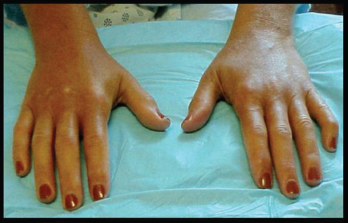
American College of Rheumatology
CHICAGO—Can non-drug interventions improve the lives of patients with scleroderma? Janet L. Poole, PhD, OTR/L, professor and director of the Occupational Therapy Graduate Program of the School of Medicine, University of New Mexico, Albuquerque, addressed this question when she presented the ARHP Distinguished Lecture at the 2018 ACR/ARHP Annual Meeting. She discussed the challenges faced by people with scleroderma as they manage their daily activities and summarized the evidence for non-pharmacological interventions for symptom management to improve the quality of life for these patients.
Disease Overview
Scleroderma, also known as systemic sclerosis, is a rare connective tissue disease that results in skin thickening, vascular insufficiency and fibrosis of internal organs. Approximately 60,000–100,000 people in the U.S. have the systemic form of scleroderma, a multi-system disease that includes organ involvement. People with scleroderma can develop painful calcium deposits under the skin on the fingers and over some larger joints, and they may have difficulty with swallowing due to problems moving food through the esophagus, Dr. Poole explained.
About 95% of people with scleroderma have Raynaud’s phenomenon and may develop digital ulcers as a result of vascular problems. Contractures can develop in the finger joints; people may lose the ability to fully straighten the middle joints of the fingers. This type of joint contracture translates to an increased likelihood the patient will bump the joint, forming ulcers that may be slow to heal due to ischemia and repeated irritation. Ulcers and joint contractures can result in decreased motion, dexterity and function in the hand. Because use of the hands is necessary for most activities of daily living, these impairments can have a significant negative effect on quality of life.
Scleroderma can cause a change in facial appearance as well, Dr. Poole stated. The skin on the face can become tight and, in some people, spidery blood vessels can appear on the face. Tight facial skin and fibrosis of the tendons can lead to decreased mouth opening. That, in turn, can make oral and dental care more difficult.
Earlier diagnosis and more effective medical and pharmacological treatment have meant people are living longer with scleroderma and experience more disability in their work, family and social lives. Between five and 10 years following diagnosis, approximately one-third of patients are work disabled, and by 20 years post-diagnosis, more than half of patients are work disabled. However, as the disease progresses, Dr. Poole explained, many patients learn to adapt and secure support.
Four literature reviews revealed the evidence in support of non-pharmacological interventions is accumulating.
4 Literature Reviews
Dr. Poole has studied the needs of patients with scleroderma, as well as the non-pharmacological interventions developed to help this patient population. To date, four literature reviews have been conducted on interventions for scleroderma. The first review, performed in 1995, concluded adjunctive therapies, such as physical and occupational therapy, although not well studied, may be helpful in preventing secondary disability.1
The second review, in 1997, included six intervention studies and noted that no control trials had been performed in rehabilitation.2
The 2010 review summarized 14 studies and four randomized, controlled trials on musculoskeletal interventions. Although the studies were small, they suggested exercise and physical activity could be beneficial.3
The 2015 review included 23 studies, nine randomized, controlled trials and four controlled clinical trials.4 Again, although exercise appeared beneficial, the strength of the evidence was limited by the great variety of the interventions. Taken together, however, the four literature reviews revealed the evidence in support of non-pharmacological interventions is accumulating.
A closer examination of the currently available evidence for non-pharmacological interventions for scleroderma suggests it is fairly strong. Dr. Poole noted scleroderma is a rare disease, so it is noteworthy that many of these studies had 20–30 patients per arm. The 2015 review article, which she co-authored, identified four studies that fell under the category of comprehensive multidisciplinary programs.4 These included land- and water-based programs; home programs; general stretching exercises for the arms, legs, face and mouth; and strengthening exercises for the arms and legs. The review found these multidisciplinary programs were associated with improvements in quality of life and functional ability.
Unfortunately, the improvements were generally not maintained after follow-up, which typically occurred six months to a year after termination of the official program. “What happens a lot of time with exercises is that people don’t continue to do them,” explained Dr. Poole.
Using Patient Needs to Guide Treatment
Dr. Poole emphasized the importance of using evidence and patient needs to guide treatment. She encouraged healthcare providers to become aware of and point patients to credible resources and tools. In particular, she highlighted the Taking Charge of Systemic Sclerosis (TOSS) internet self-management program. TOSS, developed with input from people with scleroderma, consists of educational modules, resources and videos on such topics as scleroderma, organ involvement, exercises, coping with and managing pain, fatigue, ulcers, activities of daily living and tips for caregivers. Dr. Poole also directed the audience to other resources, such as the Scleroderma Foundation, the Scleroderma Research Foundation and the Scleroderma Patient-centered Intervention Network (SPIN).
Lara C. Pullen, PhD, is a medical writer based in the Chicago area.
References
- Alpiner N, Oh TH, Hinderer SR, Brander VA. Rehabilitation in joint and connective tissue diseases. 1. Systemic diseases. Arch Phys Med Rehabil. 1995 May;76(5 Spec No):S32–S40.
- Casale R, Buonocore M, Matucci-Cerinic M. Systemic sclerosis (scleroderma): An integrated challenge in rehabilitation. Arch Phys Med Rehabil. 1997 Jul;78(7):767–773.
- Poole JL. Musculoskeletal rehabilitation in the person with scleroderma. Curr Opin Rheumatol. 2010 Mar;22(2):205–212.
- Willems LM, Vriezekolk JE, Schouffoer AA, et al. Effectiveness of nonpharmacologic interventions in systemic sclerosis: A systematic review. Arthritis Care Res. 2015 Oct;67(10):1426–1439.



